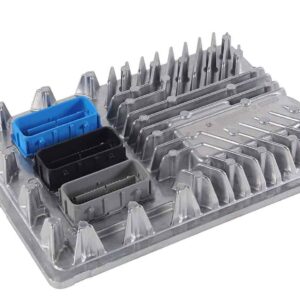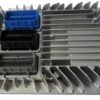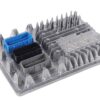Restore Peak Performance to Your GM Vehicle
If you’re battling frustrating issues like intermittent stalling, a no-start condition, or a dashboard full of warning lights on your 2017 Suburban 1500, a failing Engine Control Module (ECM) is often the culprit. As an automotive diagnostician with over two decades of experience, I’ve seen firsthand how a faulty ECM can cripple a perfectly good engine. This module, part number 12678815, is the central command center for your engine, and when it fails, it can cause a cascade of problems. We solve this by providing a reliable replacement ECM, professionally programmed with the latest GM software specifically for your vehicle’s VIN.
A Technician’s Notebook: The Intermittent No-Start Mystery
A customer brought in a 2017 Tahoe—a sister vehicle to the Suburban—with a maddening intermittent no-start. It would run fine for days, then refuse to crank. There were no consistent trouble codes, just a generic U0100 ‘Lost Communication with ECM’ that would pop up occasionally. We checked all the usual suspects: battery, starter, grounds, and the integrity of the CAN bus wiring. Everything tested perfectly. On a hunch, I monitored the ECM’s internal temperature with a scan tool. We discovered that on hot days, after a short soak, the module’s temperature would spike just before the no-start occurred. The heat was causing an internal solder joint to fail. Replacing the ECM with a pre-programmed unit like this one solved the problem permanently. It’s a classic failure mode I’ve diagnosed on dozens of these GM platforms.
Is Your GM Exhibiting These Failure Signs?
A failing engine computer doesn’t always mean a dead vehicle. The symptoms can be subtle at first. Here are the most common signs I see in my shop that point directly to a needed 2017 Suburban 1500 ECM replacement:
- ✔ Vehicle refuses to start or cranks but won’t turn over.
- ✔ Check Engine Light is on with ECM-specific Diagnostic Trouble Codes (DTCs) like P0601, P0606, or P060C (Internal Control Module Processor Error).
- ✔ Loss of communication codes, such as the infamous U0100.
- ✔ Poor engine performance, hesitation, or misfires.
- ✔ Unexplained drop in fuel economy.
- ✔ Issues with the transmission shifting properly, as the ECM and TCM must communicate.
Your Straightforward Installation Path
Getting your truck back on the road is our top priority. While professional installation is always an option, a skilled DIYer can handle this job. The most critical part is the post-installation procedure.
- Safety First: Always disconnect the negative terminal from your vehicle’s battery before starting any electrical work.
- Locate the ECM: On most GM trucks and SUVs like the Suburban, the ECM is located in the engine compartment on the driver’s side, near the firewall or inner fender.
- Disconnect and Remove: Carefully unplug the wiring harness connectors. They have locking tabs that must be released. Then, unbolt the old module from its mounting bracket.
- Install the New Module: Bolt your new, pre-programmed ECM into place. Firmly reconnect the wiring harnesses, ensuring they click securely into position.
- Reconnect Power: Reattach the negative battery terminal.
- CRITICAL FINAL STEP – Security Relearn: If your vehicle does not start after installation, you MUST perform a Vehicle Theft Deterrent (VTD) relearn. This procedure syncs the new ECM to your vehicle’s anti-theft system and requires a GM-compatible programming tool like Tis2web or Techline Connect. This is the responsibility of the installer. Other procedures like a crankshaft variation relearn may also be necessary.
Verified Fitment For These GM Vehicles
This ECM is a direct replacement for part numbers 12692068, 12704476, 12686382, 12674052, 12674472, and 12678815. It is guaranteed to fit the following models:
- ✔ 2017 Cadillac Escalade & Escalade ESV
- ✔ 2017 Cadillac XTS (3.6L Twin Turbo, VIN 8)
- ✔ 2017 Cadillac CTS (6.2L Supercharged or 3.6L Twin Turbo)
- ✔ 2017 Cadillac ATS (3.6L, VIN Y)
- ✔ 2017 Chevrolet Corvette
- ✔ 2017 Chevrolet Tahoe
- ✔ 2017 Chevrolet Suburban 1500
- ✔ 2016-2018 Chevrolet Silverado 1500 (check specific ID)
- ✔ 2017 GMC Yukon & Yukon XL 1500
- ✔ 2016-2018 GMC Sierra 1500 & Sierra Denali 1500 (check specific ID)
Frequently Asked Questions
Why do you need my VIN?
Your Vehicle Identification Number (VIN) allows us to program the ECM with the exact software and calibrations your specific vehicle requires. This ensures compatibility with your engine, transmission, and other options, and includes the latest performance and reliability updates from GM.
What is a Vehicle Theft Deterrent (VTD) relearn?
The VTD system prevents theft by ensuring the ECM, ignition key, and other modules recognize each other. When you install a new ECM, this link is broken. The relearn procedure re-establishes that secure connection, allowing the engine to start. It is a mandatory security step on modern GM vehicles.
Can I perform the VTD relearn myself?
Performing the VTD relearn requires access to GM’s official programming software, Tis2web or Techline Connect, and a compatible J2534 interface tool. While some advanced DIYers may have this, most customers will need to have a professional repair shop or mobile technician with the correct equipment perform this final step.
What happens if I don’t do the other relearns?
Procedures like the crankshaft position variation relearn help the ECM fine-tune engine timing for smooth operation and accurate misfire detection. Skipping it can lead to a persistent Check Engine Light or rough running. It’s best to complete all required setup procedures for optimal performance.
Is this a guaranteed fix for my vehicle?
This module will fix problems directly caused by a faulty ECM. However, it’s crucial to properly diagnose the issue first. Problems like bad wiring, faulty sensors, or poor grounds can mimic ECM failure. We sell a quality, correctly programmed part; proper diagnosis is key to a successful repair.



